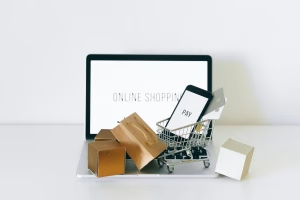In today’s fast-paced, digital-first world, it’s easier than ever to start an e-commerce business. Whether you’re a budding entrepreneur, an existing business owner looking to go online, or someone who’s simply exploring new revenue streams, the world of e-commerce offers endless opportunities.
Still, the thought of setting up an online store can feel overwhelming. How do you create a website? Which platform should you choose? How will you attract customers? Don’t worry—we’ve got you covered. This guide is designed to demystify the e-commerce process, helping you set up your store, grow your brand, and start making sales, all without the headache.
Why E-commerce?
Before diving into the how, let’s quickly talk about why e-commerce is such a great business option.
- Low Startup Costs: You don’t need a physical store or inventory to start selling. With the drop-shipping model, for example, you can launch a business without ever touching a product.
- Global Reach: Unlike a brick-and-mortar shop, an online store allows you to reach customers all over the world. Your potential audience is far bigger, and you’re open 24/7.
- Flexible and Scalable: E-commerce gives you the flexibility to work from anywhere and scale your business at your own pace. Whether you’re selling physical products, digital downloads, or even services, the possibilities are endless.
Step 1: Choose Your E-commerce Platform
The first decision you’ll make is choosing the right e-commerce platform. With so many platforms available, it can be tricky to know which one will best suit your needs. The good news? Each platform has its strengths, and most are user-friendly.
Here are three popular options to consider:
Shopify
Shopify is one of the most popular e-commerce platforms for a reason—it’s incredibly easy to use. Even if you have no tech experience, Shopify allows you to build a beautiful, fully functional online store in no time. It comes with built-in marketing tools, secure payment gateways, and a vast library of themes and apps to customize your store.
Why choose Shopify?
- User-friendly interface
- Wide range of customizable themes
- Comprehensive app marketplace
WooCommerce
If you already have a WordPress site or prefer using WordPress, WooCommerce is a fantastic option. It’s a free plugin that transforms your website into a fully functional e-commerce store. With WooCommerce, you get flexibility, control over every aspect of your store, and the ability to integrate with WordPress’s massive library of plugins.
Why choose WooCommerce?
- Highly customizable
- Free to use (with paid add-ons)
- Works seamlessly with WordPress
BigCommerce
BigCommerce is a powerful platform that caters to businesses looking for scalability. If you’re planning to grow quickly and want a platform that will grow with you, BigCommerce has robust features, including multi-channel selling, advanced SEO tools, and no transaction fees.
Why choose BigCommerce?
- Scalable and flexible
- Excellent SEO features
- Supports multiple sales channels (eBay, Amazon, etc.)
Step 2: Design Your Online Store
Once you’ve chosen your platform, it’s time to design your store. A well-designed, user-friendly website will build trust with potential customers and encourage them to make a purchase.
Here are a few tips for designing a successful e-commerce store:
Choose a Clean, Professional Theme
Your website’s design is the first impression visitors will have of your brand. Choose a theme that reflects your brand identity while keeping things simple and clean. Too many elements or an overly busy layout can overwhelm customers and cause them to leave.
Optimize for Mobile
With more and more people shopping on their smartphones, it’s crucial that your online store is mobile-friendly. Most platforms offer responsive themes that automatically adjust to different screen sizes, but it’s important to test how your site looks and functions on mobile devices.
Focus on User Experience (UX)
A smooth, intuitive user experience is key to converting visitors into buyers. Here are a few best practices:
Easy navigation: Make it simple for customers to find what they’re looking for with clear menus and search functionality.
High-quality images: Use professional photos of your products that showcase them from multiple angles.
Fast loading times: Ensure your website loads quickly—slow sites drive users away.
Step 3: Add Your Products
Next, it’s time to add your products. This is where you’ll need to shine—product listings are the heart of your e-commerce store. Follow these tips for creating listings that convert:
Write Compelling Product Descriptions
Your product descriptions should be more than just a list of features—they should tell a story. Highlight the benefits of your products and explain how they solve a problem or fulfill a need. Use descriptive language that helps customers visualize using the product.
Use High-Quality Images
Great product images can make or break a sale. Include multiple, high-resolution photos that show your product from different angles. If possible, include photos of the product in use, so customers can see it in action.
Set Competitive Pricing
Do some research on your competitors’ pricing to ensure your products are competitively priced. Don’t just aim to be the cheapest—make sure your prices reflect the value of your product.
Step 4: Set Up Payment and Shipping
Once your products are listed, it’s time to set up the logistics—how will customers pay for their purchases, and how will you get products to them?
Payment Gateways
E-commerce platforms typically integrate with several payment gateways, like PayPal, Stripe, and credit card processors. Choose a gateway that offers a smooth experience for your customers and low transaction fees for you.
Shipping Methods
You’ll also need to choose your shipping methods. Will you offer free shipping, charge a flat rate, or use real-time carrier rates? Be sure to clearly communicate your shipping policy to customers to avoid confusion.
If you’re drop-shipping, your supplier will handle shipping for you. Just make sure to check delivery times and set clear expectations with your customers.
Step 5: Market Your Store
Now that your store is set up, the next step is getting people to visit. Without marketing, even the most beautifully designed store won’t attract customers. The key to a successful e-commerce business is driving traffic and converting that traffic into sales.
Here’s how to get started with marketing:
Leverage Social Media
Social media platforms like Instagram, Facebook, and TikTok are powerful tools for promoting your e-commerce business. Share engaging content, connect with potential customers, and promote your products through social ads or influencer collaborations.
Invest in SEO
Search Engine Optimization (SEO) is crucial for driving organic traffic to your store. Use relevant keywords in your product descriptions, titles, and meta tags, and ensure your website is fast and mobile-friendly. The better optimized your store is for search engines, the more likely customers will find you.
Start an Email List
Email marketing remains one of the most effective ways to drive repeat sales. Offer a discount or incentive to encourage customers to sign up for your email list, and send out regular updates, promotions, and product recommendations to keep them coming back.
Use Paid Advertising
Consider using paid advertising, such as Google Ads or Facebook Ads, to target specific audiences. You can set a budget that works for you and reach potential customers based on their interests, location, and shopping behavior.
Step 6: Analyze and Optimize
Once your store is up and running, don’t just sit back and wait for the sales to roll in. Continuously analyze your data to understand what’s working and what isn’t. Most e-commerce platforms offer built-in analytics tools to track your sales, traffic, and customer behavior.
Look for areas of improvement, such as optimizing product pages, improving your marketing efforts, or tweaking your pricing. E-commerce is an ever-evolving process, so stay agile and be ready to make changes as needed.
Conclusion: E-commerce is Easier Than You Think
Starting an e-commerce business might seem daunting, but with the right approach, it can be incredibly rewarding. From choosing the right platform to marketing your store, each step is a building block towards success. Take things one step at a time, stay focused on your customers, and always look for opportunities to improve.
Ready to dive into e-commerce? Start by selecting your platform, designing a sleek store, and watching your business take off. It’s easier than ever to start selling online—what are you waiting for?





